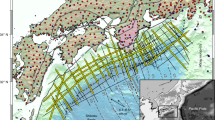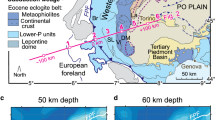Abstract
ACCORDING to the theory of plate tectonics, relatively rigid plates are bounded by large faults; plate motion has negligible internal strain1,2,with significant toroidal component to the velocity3. By contrast, models of mantle flow with viscous rheology in an intact medium predict little toroidal component and substantial internal strain in surface motion4. It has been suggested5 that the observed characteristics of plate motion are related to faulted plate margins, which are observed to be weak6. Here we confirm this suggestion, using three-dimensional models of mantle flow that incorporate faults and the forces exerted on plates by subducting slabs ("slab pull') and mid-ocean ridges ('ridge push'). Our models show that plate-like motion results from the interaction between weak faults and a strain-weakening power-law rheology. Weak transform faults tend to guide plate motion. This guiding effect and the decoupling that occurs at thrust faults may result in oblique subduction. Convergent margins are associated with realistic trench and fore-bulge topography. By simultaneously predicting surface kinematics, topography and gravity, the models achieve a useful degree of tectonic realism.
This is a preview of subscription content, access via your institution
Access options
Subscribe to this journal
Receive 51 print issues and online access
$199.00 per year
only $3.90 per issue
Buy this article
- Purchase on Springer Link
- Instant access to full article PDF
Prices may be subject to local taxes which are calculated during checkout
Similar content being viewed by others
References
Wilson, J. T. Nature 207, 343–347 (1965).
Morgan, J. W. J. Geophys. Res. 73, 1959–1982 (1968).
Hager, B. H. & O'Connell, R. J. J. Geophys. Res. 84, 1031–1048 (1979).
Christensen, U. R. & Harder, H. Geophys. J. Int. 104, 213–226 (1991).
Hager, B. H. & O'Connell, R. J. J. Geophys. Res. 86, 4843–4867 (1981).
Lachenbruch, A. H. & Sass, J. H. Geophys. Res. Lett. 15, 981–984 (1988).
Zhong, S. & Gurnis, M. J. Geophys. Res. 99, 15683–15695 (1994).
Zhong, S. & Gurnis, M. Science 267, 838–843 (1995).
Ranalli, G. Rheology of the Earth 326–336 (Chapman & Hall, London, 1995).
Moresi, L. N. & Gurnis, M. Earth Planet. Sci. Lett. 138, 15–28 (1996).
Gable, C. W., O'Connell, R. J. & Travis, B. J. J. Geophys. Res. 96, 8391–8405 (1991).
Jarrard, R. D. Rev. Geophys. 24, 217–284 (1986).
Richards, M. A. & Engebreson, D. C. (abstr.) EOS (spring suppl.) 75, 63 (1994).
McCaffrey, R. Pur. Appl. Geophys. 142, 173–224 (1994).
Author information
Authors and Affiliations
Rights and permissions
About this article
Cite this article
Zhong, S., Gurnis, M. Interaction of weak faults and non-newtonian rheology produces plate tectonics in a 3D model of mantle flow. Nature 383, 245–247 (1996). https://doi.org/10.1038/383245a0
Received:
Accepted:
Issue Date:
DOI: https://doi.org/10.1038/383245a0
This article is cited by
-
Lasting mantle scars lead to perennial plate tectonics
Nature Communications (2016)
-
The effects of rheological decoupling on slab deformation in the Earth’s upper mantle
Studia Geophysica et Geodaetica (2013)
-
Reconciling surface plate motions with rapid three-dimensional mantle flow around a slab edge
Nature (2010)
-
Evolution and diversity of subduction zones controlled by slab width
Nature (2007)
-
Numerical simulation for the prediction of the plate motions: Effects of lateral viscosity variations in the lithosphere
Earth, Planets and Space (2001)
Comments
By submitting a comment you agree to abide by our Terms and Community Guidelines. If you find something abusive or that does not comply with our terms or guidelines please flag it as inappropriate.



